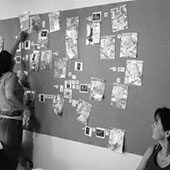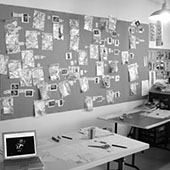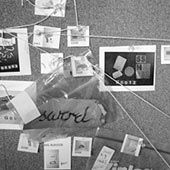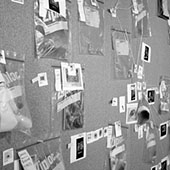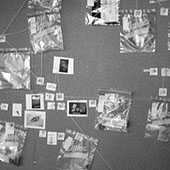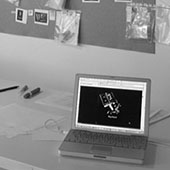Procedure
Heuristic Procedure for Generating Art Items
The following is an abstract description of an heuristic (step-by-step) process for generating art items.
Agents
The generalized Black Box procedure requires n Agents, where n>1. A generalized Agent is designated “A”. For this investigation, n=3 and the three Agents are designated B, G, and S:
- B = Rebecca Diederichs
- G = Gordon Hicks
- S = Sally McKay
Items
An Item is a physical thing, or collection of physical things. A Container (i.e. ziplock bag) defines the extent of each Item. The generalized Item is designated x.
There are no global rules governing the substance or composition of Items, except those of practicality (it needs to be transported easily) and safety (toxic, radioactive, explosive and other hazardous materials should be avoided). An Agent may develop material specifications or restrictions based on their own internal rules.
Transformations
Each Agent is able to perform either a Fusion Transformation, designated a( ), or an inverse Fission Transformation, designated a–1( ) .
A Fusion Transformation requires at least two items, and generates a single resultant item:
a(x1, x2, …) —> xr
A Fission Transformation has as an input a single item, and a single item as the output:
a–1(x) —> {xr1, xr2, …}
The rules governing the Transformations are developed internally by individual Agents but are subject to the following meta-rules:
- 1. Transformations must seek to maximize the meaning of the item.
- 2. Transformations must seek to minimize the arbitrariness of the item.
Specific and unique rules may exist within the domain of each Agent. For example, an Agent may institute a rule that all red things must be painted green for personal psychological reasons. From the point of view of this definition, Transformation rules exist only inside the black box of a particular Agent domain, and are invisible externally.
For the current investigation, the Transformations available to each Agent are:
- B : b( ) and b–1( )
- G : g( ) and g–1( )
- S : s( ) and s–1( )
Communications
Agents may Communicate only by passing items to another Agent.
With respect to the realm of this investigation, all Communications between Agents are limited to exchange of Items. In order to maintain experimental hygiene no other channels of Communication are permitted.
All forms of Communications — including pencil scribblings on paper, spreadsheets and self-destructing tape recordings — are permitted as long as the Communication is contained within the Item Container, and is thus defined as an element of the Item.
The destination of a Communication is always another Agent. The specific destination for each item is determined by rules developed at the Agent domain level.
Notation and Documentation
Each item is documented after Transformation and before it is Communicated to the next Agent. Each Communication is assigned a unique identifier code by the sender.
In this investigation, a serial number system is used:
- B0001, B0002, B0003, etc., for items sent by Rebecca Diederichs
- G0001, G0002, G0003, etc., for items sent by Gordon Hicks
- S0001, S0002, S0003, etc., for items sent by Sally McKay
